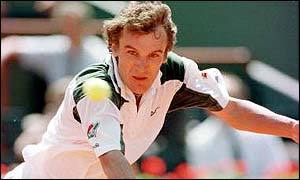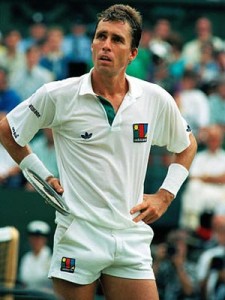U.S. Open Classic: 1988 Men’s Final

Mats Wilander's classic win over Ivan Lendl was his third major title of the year, but the last of his career.
The Set Up
1988 was a spectacular year to be a sumptuous Swedish male tennis pro. They were well on their way to winning a “Swedish” grand slam with Mats Wilander seizing the Australian and French Open crowns while Stefan Edberg captured the Wimbledon championship.
The only obstacle blocking this newfound national dream was an immovable object in the form of Czechoslovakian Ivan Lendl. Ranked world No. 1, Lendl had won three U.S. Opens in succession and he appeared to have an iron lock on New York, the city where he never seemed to lose anymore.
Furthermore, if he succumbed to Mats Wilander, Lendl would lose the No. 1 ranking he had held for 159 consecutive weeks, and Wilander would become both the first Swedish winner of the U.S. Open as well as the world’s new top player.
The U.S. Open title had always eluded the most famous Swede of all—one Bjorn Borg. It became his Achilles’ heel.
On his way to the final Lendl swatted aside the pesky newcomer—18-year-old, brash and outrageous Andre Agassi—who was clearly the crowd favorite. Lendl complained to the chair umpire during the first set about the grunts emanating from the teen-age wunderkind. This did not please Agassi or his legion of boisterous fans.

The loss to Wilander in the U.S. Open finals dropped Lendl from the top spot in the world rankings.
Wilander, on the other hand, made short and definitive work in his semi-final against unseeded Aussie Darren Cahill 6-4, 6-4, 6-2.
The 1988 final would be a rematch of the previous year.
In 1987, Lendl and Wilander played in the finals of the U.S. Open in a marathon match that took 4 hours and 47 minutes. Lendl finally prevailed, 6-7, 6-0, 7-6, 6-4.
When Lendl and Wilander met, neither could be hurried nor rushed. Their matches lasted hours upon hours, becoming veritable endurance contests as the baseliners slugged it out. Their cat-and-mouse strategy sessions on court were legendary.
1988 would go down in the books as the longest U.S. Open in the history of the tournament. It was an epic struggle with neither combatant willing to give an inch in his determination to win.
The Match
Wilander understood from the outset what it would take to defeat his arch rival Ivan Lendl. There could be no loose points or rash reactions. Everything depended on consistency and control. Luckily, there was no one more equal to the task on this day than Mats Wilander, who had waited his whole career for this moment.
Many of their rallies lasted for 30 or 40 strokes before one of them finally misfired and lost the point. The first set was dead even for the first seven games with long and often tedious exchanges.
Playing the odds, Wilander finally scored a break point in the eighth game going up 30-40; but Lendl converted the next point and they arrived at deuce. Under pressure, Lendl served it out and they were even at 4-all.
Wilander then held serve to go up 5-4. Taking a deep breath, Mats knew that this was his big chance.
Lendl stepped up to the plate, however, and served three aces to go up 40-15. He nodded in approval and some relief flashed over his stern features. But then he double-faulted and watched in disgust as Wilander nailed an overhead to take it to deuce.
When Lendl hit a backhand into the net, Wilander got his first set point. On the next point, unfortunately for him, Wilander sent his backhand wide.
At deuce again, Lendl sent a backhand into the net to give Wilander another set point, and this time the Swede capitalized by rushing the net and forcing Lendl to hit a backhand long.
Wilander took the first set in 61 minutes.
In the second set, Lendl continued to misfire on his backhand. It cost him dearly as he lost his serve in the second game. Errors mounted on the Czech’s side of the ledger. Finally Wilander went up 4-1 after saving five break points on his own serve.
The Swede was unflappable, dialed into the match and seemingly ready for anything the stony Czech could throw at him.
But an outside force disrupted Wilander’s hold on Lendl’s jugular. That is when Lendl began his comeback.
When the chair umpire gave Wilander a warning for taking too much time before serving at 30-all in the seventh game, the Swede lost his concentration and promptly lost his serve. In fact, Wilander only won four more points and Lendl grabbed the second set, 6-4.
In the third set, once again Wilander broke Lendl’s serve in the second game on his way to securing another 4-1 advantage. This time, however, the Swede maintained his steely hold on the match and his own serve and seized the third set, 6-3.
Up two sets to one, Wilander settled back into his careful dance with Lendl, featuring extended rallies and cat-and-mouse tactics, each seeking to out wait the other, hoping the next stroke would produce an error.
The fourth set appeared to be heading for a tie break when Wilander unexpectedly broke the Czech’s serve in game number 7. The big man had simply collapsed hitting back to back forehand errors. Wilander went up 4-3; but was unable to capitalize on his advantage.
Lendl broke back, leveling the set at 4-all. After this flurry, the players settled comfortably back into conservative play, each holding until the 12th game, when Lendl held a 6-5 advantage.
In that fateful game, Wilander fell behind 15-40. Lendl wasted his first set point by powering a forehand into the net. But on the second set point, Lendl lunged and planted a forehand right on the line.
On to the fifth and final set
There had not been a fifth set at the U.S. Open since the Bjorn Borg vs. John McEnroe final of 1980.
Wilander promptly broke Lendl’s serve in the opening game, eventually securing a 2-0 lead in the final set after saving two break points on his own serve.
The Czech was not finished, however, and won the next three games to go up 3-2. They were back on serve. Wilander’s break came in the seventh game when his constant presence at the net forced Lendl to spray his passing shots wide of the mark.
On break point, Wilander ripped a forehand winner down the line. Wilander came to the net 131 times during the match, winning 58 percent of those forays. By contrast, Lendl ventured into the net 77 times.
The end was nigh: Wilander served it out, saving two break points. The final point came when Lendl hit a backhand into the net. Mats Wilander won the U.S. Open 6-4, 4-6, 6-3, 5-7, 6-4 in the longest match in U.S. Open history, lasting four hours and 54 minutes, or almost an hour per set.
The match began at 4:22 p.m. and ended at 9:17 p.m. with the crowd shrinking from 20,036 to 8,000 as play crept along at a seeming snail’s pace. The quality of play, however, improved vastly as the match progressed.
Wilander had fallen to Lendl in their last six meetings. But as Wilander joked “Nobody beats me seven times in a row!” This line has been carried forward and reissued by the likes of Andy Roddick in speaking of his lopsided losing record against Roger Federer.
In Lendl’s seventh appearance at the U.S. Open, he was going for his fourth consecutive title.
In the finest year of his career, Mats Wilander became the No. 1 player in the world after winning this U.S. Open title. He won three of the four majors in 1988. This victory propelled him into the history books.
JA Allen is a regular contributor for Sports Then and Now.









